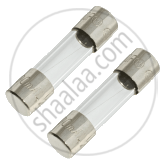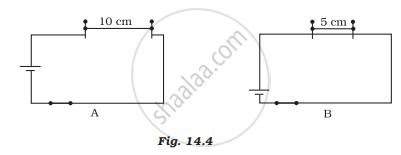Advertisements
Advertisements
प्रश्न
An electric heater of resistance 8 Ω draws 15 A from the service mains 2 hours. Calculate the rate at which heat is developed in the heater.
उत्तर
Resistance of the electric heater, R = 8 Ω
Current I = 15 A
Time, t = 2 hr.
Rate of generation of heat = I2 × R
= (15)2 × 8
= 255 × 8
= 1800 W
Therefore, heat is produced by the heater at a rate of 1800 W.
APPEARS IN
संबंधित प्रश्न
Name any two effects of electric current.
What is nichrome? State its one use.
Why is a series arrangement not used for connecting domestic electrical appliances in a circuit?
An electric iron is connected to the mains power supply of 220 V. When the electric iron is adjusted at 'minimum heating' it consumes a power of 360 W but at 'maximum heating' it takes a power of 840 W. Calculate the current and resistance in each case.
Give Scientific reason.
In practice, the unit kWh is used for the measurement of electrical energy, rather than joule.
Identify the figure and give its use.

Which of the following substance contracts on heating?
Find the odd one out and give its explanation.
Which metal is used to make the filament of an electric bulb?
Assertion: Bending of wire decreases the resistance of the electric wire.
Reason: The resistance of a conductor depends on length, thickness, nature of material and temperature of the conductor.
An electric kettle consumes 1 kW of electric power when operated at 220 V. A fuse wire of what rating must be used for it?
What is Joule’s heating effect? How can it be demonstrated experimentally? List its four applications in daily life.
Paheli took a wire of length of 10 cm. Boojho took a wire of 5 cm of the same material and thickness. Both of them connected the wires as shown in the circuit given in Figure 14.4. The current flowing in both circuits is the same.
(i) Will the heat produced in both cases be equal? Explain
(ii) Will the heat produced be the same if the wires taken by them are of equal lengths but of different thicknesses? Explain.

An electric fuse has a body made of ceramic and two points for connecting the fuse wire.
Copper wire offers very little ______ and does not get heated up quickly.
Match the following
| 1. | Bulb | a. | Conductor |
| 2. | Electroplating | b. |
Insulator |
| 3. | Pure water | c. | Heating effect of current |
| 4. | Salt solution | d. | Chemical effect of current |
The following is not a safety device.
An electric fuse is a wire made up of a material having ______ melting point.
State the law that explains the heating effect of current with respect to the measurable properties in an electrical circuit.
